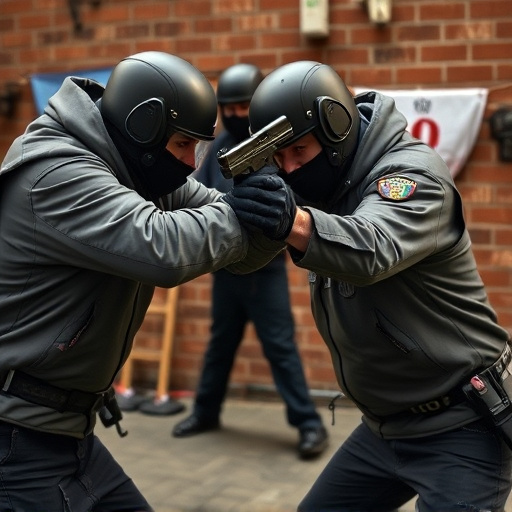Pepper spray, a well-studied riot control agent, offers an off-label solution for law enforcement facing aggressive canine threats. Effective in distracting and temporarily incapacitating dogs, it provides crucial time to assess high-risk situations. However, proper training is vital for safe and effective use, especially around protected or trained dogs. The legal framework governing its use prioritizes public safety and animal welfare, ensuring responsible deployment while respecting ethical considerations. Armed with this knowledge, officers can confidently manage dog encounters, maintaining safety for both themselves and the community.
In the realm of law enforcement, effective riot control agents are essential tools for managing chaotic situations and ensuring officer safety. Among these, pepper spray has gained prominence as a defense mechanism against aggressive dogs. This article delves into the strategic use of riot control agents, focusing on pepper spray’s efficacy in canine encounters. We explore the legal framework governing their application and discuss critical safety measures when integrating dog handling and pepper spray tactics.
- Pepper Spray: Effective Against Canine Aggression?
- Legal Framework: Riot Control Agents in Law Enforcement
- Dog Handling & Pepper Spray: Safety Measures for Cops
Pepper Spray: Effective Against Canine Aggression?
Pepper spray, a common riot control agent, has been extensively studied for its effectiveness in law enforcement scenarios. While its primary use is to disrupt and incapacitate individuals during violent demonstrations or criminal activities, recent research has explored an intriguing off-label application: defending against canine aggression. Dogs, especially those trained for protection or law enforcement purposes, can pose significant risks to officers on the ground. Pepper spray has emerged as a potential tool to mitigate these risks, providing a non-lethal means of controlling and de-escalating potentially dangerous situations involving dogs.
Studies suggest that pepper spray can be effective in distracting and temporarily incapacitating aggressive dogs, giving officers crucial time to assess the situation and take appropriate actions. The capsaicin, the active ingredient in pepper spray, irritates the dog’s eyes, nose, and respiratory system, leading to temporary blindness, coughing, and difficulty breathing. This reaction allows officers to gain control of the animal and protect themselves until backup arrives. However, it is essential for law enforcement agencies to train their personnel extensively in the responsible use of pepper spray against dogs, ensuring both safety and effectiveness during such encounters.
Legal Framework: Riot Control Agents in Law Enforcement
The legal framework surrounding riot control agents, including pepper spray, is a critical aspect of law enforcement strategy. These agents are designed to incapacitate or deter individuals during civil unrest, crowd control situations, and as a last resort when other tactics fail. However, their use is tightly regulated to ensure public safety and prevent abuse. Laws vary by jurisdiction but generally require officers to receive specialized training in the handling of riot control agents and to follow strict protocols for their deployment.
When it comes to specific applications like defense against dogs, pepper spray is often considered a less-lethal option. Its effectiveness in neutralizing aggressive canine behavior without causing permanent harm makes it a preferred choice for law enforcement in certain scenarios. Yet, even here, usage guidelines must be rigorously followed to avoid unjustified or excessive force, particularly in areas where the presence of service animals or other protected creatures is likely. This balanced approach underscores the legal and ethical considerations that guide modern riot control practices.
Dog Handling & Pepper Spray: Safety Measures for Cops
Law enforcement officers often face dangerous situations, especially when dealing with aggressive dogs. In such scenarios, dog handling and riot control agents like pepper spray become critical tools for maintaining safety. Pepper spray is a non-lethal defense mechanism designed to incapacitate dogs temporarily, giving cops valuable time to assess and de-escalate the situation. It’s particularly useful as a last resort when other control methods fail or aren’t applicable.
Training in pepper spray application against dogs involves learning proper usage and safety measures. Officers must understand the range and effectiveness of the spray while being mindful of potential risks, such as cross-contamination with other animals or bystanders. Equipped with this knowledge, cops can effectively manage dog encounters, ensuring their safety and that of the community they serve.
In conclusion, pepper spray has emerged as a valuable tool in law enforcement’s arsenal, particularly when dealing with canine aggression. However, its use must be carefully regulated and accompanied by proper training and safety protocols. The legal framework surrounding riot control agents ensures their responsible deployment, balancing public safety with animal welfare. By understanding the effectiveness of pepper spray against dogs and adhering to strict guidelines, law enforcement officers can effectively manage dangerous situations while minimizing harm.
